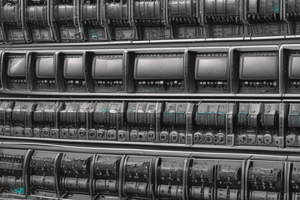Podcast
Questions and Answers
What is the primary function of a hub in a network?
What is the primary function of a hub in a network?
What is a major disadvantage of using hubs to interconnect LAN segments?
What is a major disadvantage of using hubs to interconnect LAN segments?
What is the main difference between a hub and a bridge?
What is the main difference between a hub and a bridge?
What is a broadcast domain?
What is a broadcast domain?
Signup and view all the answers
What is a collision domain?
What is a collision domain?
Signup and view all the answers
What is the advantage of using multiple hubs to extend the network length?
What is the advantage of using multiple hubs to extend the network length?
Signup and view all the answers
What is the purpose of a bridge in a network?
What is the purpose of a bridge in a network?
Signup and view all the answers
What is a characteristic of a bridge in contrast to a hub?
What is a characteristic of a bridge in contrast to a hub?
Signup and view all the answers
What is the main function of a repeater in a network?
What is the main function of a repeater in a network?
Signup and view all the answers
What type of device operates on frames or packets?
What type of device operates on frames or packets?
Signup and view all the answers
What is the result of two nodes on connected segments transmitting at the same time in a network using repeaters?
What is the result of two nodes on connected segments transmitting at the same time in a network using repeaters?
Signup and view all the answers
What type of topology is used by a hub to connect stations?
What type of topology is used by a hub to connect stations?
Signup and view all the answers
What is the primary function of a bridge in a network?
What is the primary function of a bridge in a network?
Signup and view all the answers
Which of the following devices operates on the physical layer?
Which of the following devices operates on the physical layer?
Signup and view all the answers
What is the main advantage of using repeaters in a LAN?
What is the main advantage of using repeaters in a LAN?
Signup and view all the answers
How do hubs handle incoming bits from an adapter?
How do hubs handle incoming bits from an adapter?
Signup and view all the answers
What is the primary function of a bridge in a network?
What is the primary function of a bridge in a network?
Signup and view all the answers
What is the main advantage of cut-through switching over store-and-forward switching?
What is the main advantage of cut-through switching over store-and-forward switching?
Signup and view all the answers
What is the primary function of a router in a network?
What is the primary function of a router in a network?
Signup and view all the answers
What is the main difference between a switch and a bridge?
What is the main difference between a switch and a bridge?
Signup and view all the answers
What is the primary advantage of store-and-forward switching over cut-through switching?
What is the primary advantage of store-and-forward switching over cut-through switching?
Signup and view all the answers
What is the main difference between a router and a switch?
What is the main difference between a router and a switch?
Signup and view all the answers
What is the main purpose of routing algorithms in routers?
What is the main purpose of routing algorithms in routers?
Signup and view all the answers
What is the primary function of a switch in a network?
What is the primary function of a switch in a network?
Signup and view all the answers
Study Notes
Connecting Devices
- Five types of connecting devices: Repeaters, Hubs, Bridges, Switches, and Routers
- These devices separate or expand networks and operate at different layers of the OSI model
Repeaters
- Operate at the Physical Layer
- Act on bits, not frames or packets
- Receive a bit, regenerate it, and transmit it onto all other interfaces
- Used in LANs to connect cable segments and extend the maximum cable length
- Do not implement any access method, so collisions can occur
Hubs
- Operate at the Physical Layer
- Act on bits, not frames
- Receive a bit from an adapter and send it to all other adapters
- Do not implement any access method or filtering
- Form a single collision domain and broadcast domain
- Can be used to extend the network length, but can reduce performance
Bridges
- Operate at the Data Link Layer (MAC address level)
- Used to divide a LAN into smaller segments or connect LANs with identical physical and data link layers protocol
- Each LAN segment is a separate collision domain
- Perform filtering using a table to make decisions
- Do not send received frames to all other interfaces like hubs and repeaters
Switches
- Operate at the Data Link Layer (MAC address level)
- Used to connect individual computers, not LANs
- Allow multiple devices to transmit simultaneously
- Can operate in Full-duplex mode
- Perform MAC address recognition and frame forwarding in hardware
- Use different forwarding techniques, such as store-and-forward switching and cut-through switching
Routers
- Operate at the Network Layer
- Deal with packets, not frames
- Connect LANs and WANs with similar or different protocols
- Isolate both collision domains and broadcast domains
- Act like normal stations on a network, but have multiple network addresses
- Communicate with each other and exchange routing information
- Determine the best route using routing algorithms and special software
Studying That Suits You
Use AI to generate personalized quizzes and flashcards to suit your learning preferences.
Description
This quiz covers the functions of network devices, including repeaters, hubs, bridges, routers, and switches. It tests knowledge on connecting devices in computer networks.




